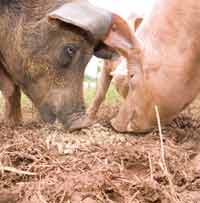Pig industry looks closer to home for protein source

The UK pig industry should be looking closer to home with regards to protein sources and with the help of the Green Pig Project being undertaken taken by SAC, peas and beans may soon be replacing imported soybean meal.
With 300,000t of soybean meal being imported each year for the UK pig industry, it is easy to see, in this time of increasing environmental importance, that sustainability is crucial.
With fluctuating prices making the market uncertain, looking closer to home for protein sources may be the only answer to a secure future.
It is not impossible to devise feeding strategies to reduce the environmental burden, says SAC research scientist Jos Houdijk.
“Several challenges face soybean meal use. With imports coming from as far as Brazil and Argentina, combined with deforestation taking place to accommodate areas to grow the meal, there is certainly a need for alternative protein sources grown closer to home,” he says.
The Green Pig Project aims to bring together plant breeders and growers, pig feed manufacturers and producers and industry organisations, to investigate on what level legumes can be used in pig nutrition.
“To replace all soybean meal we would need 500,000t of pulses a year and, with the volume of peas and beans being grown reducing from 900,000t in 2005 to 600,000t in 2008, it is crucial we have integration between growers and producers.”
With soybean meal prices ranging from £255/t in July 2008 to to £180/t in October, peas and beans are becoming a desirable alternative, says Dr Houdijk.
“Already peas and beans not making the grade for human consumption are used in animal feeds, but their nutritive value tends to be lower in protein and amino acid composition compared to soya.”
It is hoped peas and faba beans can substantially contribute to meet desired crude protein and energy levels in pig diets, with DE levels ranging from 14.4-17.5MJ/kg.
“With home-grown produce reducing feed miles and a low input of nitrogen fertiliser needed to grow the crops, because of their nitrogen fixing properties, there are considerable benefits in using them,” says Dr Houdijk.
Legumes can be included in compound feed mixtures and also appeals to those home mixing.
“France and Canada are already using legumes in compound feeds we have a lot to learn about how they use home-grown proteins,” he says.
But peas and beans are associated with anti-nutritive factors, with peas containing trypsin inhibitors trypsin is an enzyme used to break down protein.
Beans also contain condensed tannins which (above a certain level in the diet) reduce intake because of their bitter taste.
“New pea and bean varieties containing lower levels of condensed tannins and trypsin inhibitors are available, although further testing of their viability is needed,” says Dr Houdijk.
“In general, pig producers seem receptive to the idea of using legumes as long as it economical.
“Growers and pig producers must work together, particularly as crop producers are focused on pulse yield and protein content, compared with protein quality, which is required by pig producers.”

